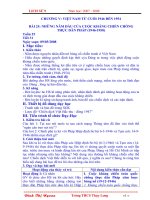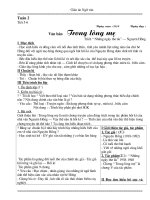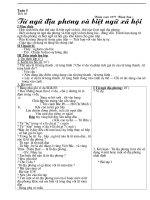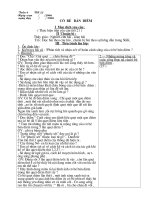lop 8 tuan 25
Bạn đang xem bản rút gọn của tài liệu. Xem và tải ngay bản đầy đủ của tài liệu tại đây (145.22 KB, 6 trang )
<span class='text_page_counter'>(1)</span>Planning date: 21/ 02/ 2014 Period: 70. Teaching date: 25/ 02/ 2014 UNIT 11: TRAVELING AROUND VIET NAM READ. I. Objectives 1. Knowledge: By the end of the lesson, Ss read for information about some places of interest in Vietnam. a. Vocabulary: Related to “Traveling Around Viet Nam” b. Grammar: Simple present tense 2. Skills: listening, speaking, reading and writing 3. Attitude: Ss will be educated about the love of our country. II. Preparation 1. Teacher: lesson plane, book, color chalks, pictures, cassette and tape 2. Students: books, notebooks, pen, ruler … III. Teaching methods - Communication approach - Question and answer, eliciting - Techniques: Ask and answer, Work in pairs/ groups, Discuss. IV. Procedures: 1. Greeting and checking the attendance (1’) 2. Review of the previous lesson (4’) Ss make request and give reply: Ex1. Turn on the lights S1: Do you mind turning on the lights? S2: All right/ I’m sorry, I can’t. Ex2: S1: Do you mind if I turn off the fan? S2: No, of course not. 3. New lesson (35’) Teacher’s and Students’ activities Content * Warm up “Chatting” - T has Ss look at the pictures of some - Do you like traveling? interesting places and asks them to tell where - Where did you travel? they are. Then T asks Ss some questions about - Did you go to Da Lat? / Nha Trang …? these places - What was the weather like? - Ss watch, listen and respond. - What do you like in Da Lat? / Nha Trang …? - Have you ever been there? - What can you see there / in Nha Trang / Da Lat …? - T presents some new words through Sts’ * Pre-Reading answers. New words: - Ss listen, repeat, give the meaning and take Onceanic institute (n) notes. giant (adj) -Ss read the new words. accommodation (n) - T asks Ss to write a list of new words and waterfall (n) write them on the board. stream (n) magnificent (n) limestone (n) florist (n) import (v)<> export (v) sunbathe (v) - T has Ss look at the exercise 1(p.104), read * While-reading : the brochures and check the topics mentioned. 1. Check the topics mentioned in the brochures about the resorts: * Answer: (1/p.104) Nha Trang: flights to Hanoi, local transport, railway, tourist attractions..
<span class='text_page_counter'>(2)</span> - Ss work individually and then compare their answers with their partners, then give the answers. - T and Ss check the answers.. - T has Ss look at the exercise 2(p.105) and help the people mentioned find a suitable places. -Ss work individually and then compare their answers with their partners, then give the answers. - T and Ss check the answers. - T has Sts ask and answer questions, using information in exercise 2. - Sts work in pairs. - T has Sts play roles, one is a tourist and one is a tourist officer, asking where to go and suggesting where he/she should go.. Dalat: hotels, local transport, tourist attractions, waterfalls. Sapa: hotels, local transport, mountain slopes, tourist attractions, villages. Ha Long Bay: caves, hotels, local transport, minihotels, sand beaches, tourist attractions, World Heritage. 2. Answer. Where should these people go? *Answer: (2/p.105) a – Sa pa b – Nha Trang c – Nha Rong Harbor d – Ha Long Bay e – Da Lat * Post-reading : “Where should … go? … should go to … Why? …………………. Because ………. ”. 4. Consolidation (4’) T reviews the use of simple present tense make sentences in the simple present. (+) S + V (s,es) (-) S + doesn’t / don’t + V (bare infinitive) (?) Does/Do + S +V (bare infinitive) …? Yes, S + do/ does. No, S + don’t / doesn’t. 5. Homework (1’) - Learn by heart new words. - Prepare: Write. V. Experience: ………………………………………………………………………………………………………………………………………………………………………… ………………………………………………………………………………………………………………………………………………………………………… …………………………………………………………………………………………………………………………………………………………………………. Planning date : 21/ 02/ 2014 Period: 71. Teaching date: 27/ 02/ 2014 UNIT 11: TRAVELING AROUND VIET NAM WRITE. I. Objectives 1. Knowledge: By the end of the lesson, students know how to arrange sentences to complete a story and how to write a story in chronological order by using the simple past tense. a. Vocabulary: Related to “Traveling Around Viet Nam” b. Grammar: Simple past tense 2. Skills: listening, speaking, reading and writing 3. Attitude: Ss will be educated about the love of our country. II. Preparation 1. Teacher: lesson plane, book, color chalks, pictures, cassette and tape 2. Students: books, notebooks, pen, ruler … III. Teaching methods - Communication approach - Question and answer, eliciting - Techniques: Ask and answer, Work in pairs/ groups, Discuss. IV. Procedures: 1. Greeting and checking the attendance (1’).
<span class='text_page_counter'>(3)</span> 2. Review of the previous lesson T asks Ss about Nha Trang, DaLat, Sa Pa, Ha Long Bay: - Do you want to visit Nha Trang? Why? Why not? What is your impression on it? 3. New lesson (39’) Teacher’s and students’ activities - T asks Sts some questions. - Ss give feedback. - T corrects if necessary. - T presents the situation of the Browns’ vacation and presents some new words Canoe, paddle, hire, overturn, rescue… - Ss copy down - Checking technique “rub out & remember ”. - T has Ss look at the events and order them. - Ss work individually and then compare their answers with their partners, then give the answers. - T and Ss check the answers. - T has some Ss read the story again. - T can ask some Questions to check Ss’ understanding. - T has Ss work in pairs look at the pictures and rearrange the events to make a story. - T has Ss write a story using words given and pictures rearranged. - Ss work individually and then compare their answers with their partners, then some Ss write the story on the board. - T and Ss check the answers.. - T has some Ss read the story again and then has one or two Ss retell the story using the pictures. 4. Consolidation(4’) T reminds ss of the past simple tense. 5. Homework(1’) Write and learn new words. Write another story (workbook). Prepare Unit 11: Language focus V. Experience:. Content * Warm up * Chatting : “Have you ever been to Da Lat? What can you see in Da lat?…” Do you like traveling? Where did you travel? * Pre-Writing : Read the first part of a story about traveling around Viet Nam. New words: - canoe (n) - paddle (v) - hire (v) - overturn (v) - rescue (v) - go off (v) - stumble(v) vấp - realize(v) nhận thấy 1. Now, put the sentences below in the correct chronological order to complete the story. Answer (1.p.106) 1-c, 2-a, 3-g, 4-d, 5-f, 6-b, 7-e * While-Writing 2. Put the events below in the correct chronological order and write the story. Start with the sentence below. Answer (p.106) 1-d, 2-b, 3-e, 4-h, 5-a, 6-f, 7-c, 8-g Answer (p.106) Uyen had a day to remember last week. She had a math exam on Friday and she got up late. She realized her alarm clock did not go off. As she was leaving home, it started to rain heavily. Uyen tried to run as fast as she could. Suddenly she stumbled against a rock and fell (onto the road) Her schoolbag went into a pool (of water) and everything got wet. Strangely, the rain stopped as she got to her classroom. Luckily, Uyen had enough time to finish her exam. * Post –writing: Retell the story.
<span class='text_page_counter'>(4)</span> ………………………………………………………………………………………………………………………………………………………………………… ………………………………………………………………………………………………………………………………………………………………………… …………………………………………………………………………………………………………………………………………………………………………. Planning date : 21/ 02/ 2014 Period: 72. Teaching date: 01/ 03/ 2014 UNIT 11: TRAVELING AROUND VIET NAM LANGUAGE FOCUS. I. Objectives 1. Knowledge: By the end of the lesson, Ss use present and past participles to describe things and people; make and respond to formal requests using “mind” and make suggestions. a. Vocabulary: (review) b. Grammar: Present participle phrase V-ing Past participle phrase V-ed / C 3 Would/do you mind + V-ing…? Do you mind if I + V(present simple)…? Would you mind if I + V(past simple)…? 2. Skills: listening, speaking, reading and writing 3. Attitude: Not available. II. Preparation 1. Teacher: lesson plane, book, color chalks, pictures, cassette and tape 2. Students: books, notebooks, pen, ruler … III. Teaching methods - Communication approach - Question and answer, eliciting - Techniques: Ask and answer, Work in pairs/ groups, Discuss. IV. Procedures: 1. Greeting and checking the attendance (1’) 2. Review of the previous lesson 3. New lesson (39’) Teacher’s and Students’ activities -T asks Ss to look at the picture on page 108. -T presents the situation. -T asks questions and calls on Ss to answer then correct. -Ss work in pairs. -T calls Ss to practice them in front of the class. -T corrects if necessary. -T presents structure and elicits the target language by asking the question below then have Ss repeat. -T explains model sentences and how to use.. -Ss copy down. -T asks Ss to practice.. Content 1. Look at the people in the schoolyard at Quang Trung school. Say who each person is. (p108) It’s time for recess and people at Quang Trung school are in the school yard. What are they doing? 1/ What’s Mr. Quant doing? He’s walking / going up the stairs. 2/ What is Miss Lien doing? She is carrying a bag / talking to Nam. 3/ What is Nam doing? He is standing next to miss Lien / talking to Miss Lien. …. Model sentences : Who is the man walking up the stairs? The man walking up the stairs is Mr. Quan. (present participle phrase) Form : V-ing present participle Use: A present participle (phrase) can be used as an adjective to qualify a noun with active meaning.. 1/ The man walking up the stairs is Mr. Quang 2/ The woman carrying a bag is Miss Lien..
<span class='text_page_counter'>(5)</span> -Ss show the cardboard and have Ss run through the situations against. -Choral -> individual. -T calls several Ss to go to the board and write their sentences. -T corrects if necessary. -T asks Ss to look at the words in the box and the picture on page 109 to do the matching. -Ss work in pairs. -T calls Ss to go to the board and match them. -T corrects if necessary.. 3/ The boy standing next to Miss Lien is Nam 4/ The boy sitting under the tree is Ba. 5/ The girl standing by the table is Lan. 6/ The girls playing chess are Nga on the right and Hoa on the left.. 2. Look at this stall. Describe the goods for sale. Use the past participles of the verbs in the box (p.109) Matching : 1. box a. wrap in 2. truck b. dress in 3. lamp c. recycled from 4. doll d. keep in 5. flowers e. make in 6. toys f. paint Key: 1 - f, 2 - c, 3 - e, 4- b, 5 –a, 6 – d. -T elicits the target language by asking the Questions : question below when have Ss repeat. 1. Where is the old lamp made in? -> China -T explains how to use. 2. What color is the box painted? -> Green -Ss copy down. 3. What is the truck recycled from? -> Cans Model sentences : -T explains how to do the exercise. The old lamp made in China is 5 dollars -Ss work in pairs. (Past par. Phrase ) -T asks Ss to practice. Form: -Ss looks at their books, listen to the questions Regular verb-ed past & answer. Irregular verb-Column 3 participle -T calls on some pairs to demonstrate for the Use: A past participle (phrase) can be used as an class. adjective to qualify a noun with passive meaning. Question – answer drill. -T asks Ss to use the right form of the verbs in 1. How much is the box painted green? the box to fill in the gaps. The box painted green is one dollar -Ss complete the sentences. 2. Truck made from recycled cans / $ 2 -T calls on several Ss to answer their 3. Doll dressed in red / $ 2 sentences. 4. Flowers wrapped in blue paper / $ 1 -T corrects and gives key. 5. Toys kept in a cardboard box $ 10 - T presents how to make formal requests and 3/ Work with a partner. Use these words to make and respond. respond to requests. 1. Would/do you mind + V-ing…? Responses: Agreement : No , I don’t mind / No , of course not /Not at all … Disagreement : I’m sorry , I can’t / I’m sorry /It’s impossible I’d rather you didn’t /I’d prefer you didn’t Ex: -T asks Ss to practice language focus 3/p.109. 1. Would you mind moving your car? No, of course not. -Ss work in pairs. b/ Would you mind putting out your cigarette ? -T calls on some Ss to practice. No, of course not. -T corrects if necessary. c/ Would you mind getting me some coffee? -T explains how to use “mind "to make I’m sorry, I’m too busy right now. request and respond. d/ Would you mind waiting a moment ? I’m sorry, I can’t. I’m already late for work..
<span class='text_page_counter'>(6)</span> -T explains how to do the exercise -4/110 -Ss work in pairs. -T calls on some Ss to practice. -T corrects if necessary.. 4. Work with a partner. Look at the pictures. Ask questions and give suitable responses. 1.Do you mind if I + V (present simple)…? 2.Would you mind if I + V (past simple)…? EX: “Do you mind if I sit down? Please do.” Or “Would you mind if I smoked? I’d rather you didn’t.” * Responses: Agreement: No, I don’t mind /No, of course not /Not at all /Please go ahead Disagreement: I’m sorry , I can’t / I’m sorry /It’s impossible/I’d rather you didn’t C/ Do you mind If I postpone our meeting? Not at all. D/ Do you mind If I turn off the stereo? I’d rather you didn’t. E/ Would you mind If I turned on the airconditioner? Please do. F/ Do you mind If I watch TV while eating lunch? No, of course not.. 4. Consolidation (4’) Use “would / Do you mind …?” to make the following sentences more polite. 1. Can I move the refrigerator to the right corner? -> Would ……………….. 2. Could I smoke? -> Do …………………… 3. May I ask you a question? -> Would ………………. 4. Could I turn the air conditioner off? -> Would ………………. 5. Homework (1’) - Practice the lesson at home again - Prepare: See unit 9, 10, 11 for revision. V. Experience: ………………………………………………………………………………………………………………………………………………………………………… ………………………………………………………………………………………………………………………………………………………………………… …………………………………………………………………………………………………………………………………………………………………………. Signature of the Leader Week 25 ..............................................................
<span class='text_page_counter'>(7)</span>









